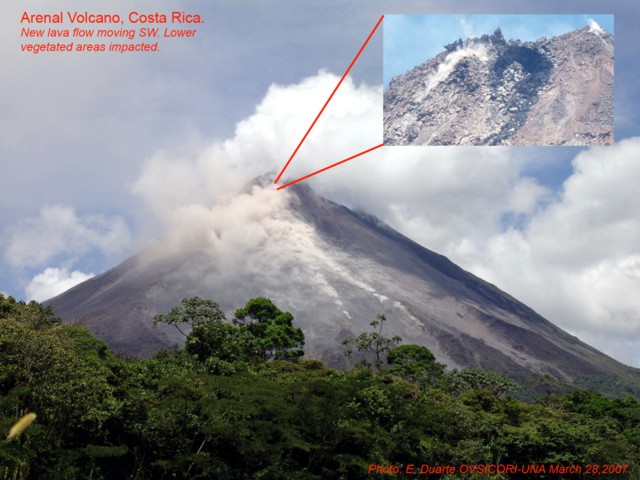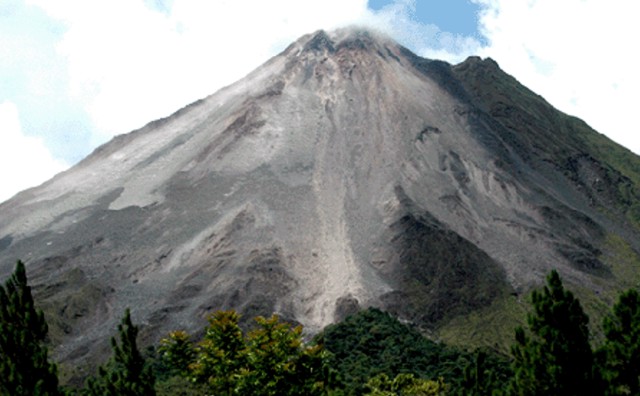Report on Arenal (Costa Rica) — September 2007
Bulletin of the Global Volcanism Network, vol. 32, no. 9 (September 2007)
Managing Editor: Richard Wunderman.
Arenal (Costa Rica) Ongoing activity during 2005-7 included lava flows and pyroclastic flows
Please cite this report as:
Global Volcanism Program, 2007. Report on Arenal (Costa Rica) (Wunderman, R., ed.). Bulletin of the Global Volcanism Network, 32:9. Smithsonian Institution. https://doi.org/10.5479/si.GVP.BGVN200709-345033
Arenal
Costa Rica
10.463°N, 84.703°W; summit elev. 1670 m
All times are local (unless otherwise noted)
Since our last report on Arenal in 2005 (BGVN 31:10), silicic lava emissions were continuous with some occasional more intense periods, including events in May 2006 and September 2007. The agency OVSICORI-UNA noted that from October 2005 through September 2007 the generally low level of activity at the main vent area at Crater C was characterized by continuous emissions of lava, gases, and periodic strombolian eruptions. Pyroclastic flows were occasionally produced, the result of collapse of an active lava flow front. The volcanism was accompanied by characteristic seismic activity, which is indicated in table 25 for the interval September 2005 - December 2006. During this period, Crater D displayed fumarolic activity only; accordingly, the discussion below focuses on activity at Crater C and the Arenal edifice. Note that during the reporting interval, the directions of materials descending the flanks has shifted from time to time.
Table 25. Seismic activity registered at Arenal's station VACR, located 2.7 km NE of the active crater, during September 2005-December 2006. Months with "--" indicate that data were not reported for that month. Data were normalized from mean values for months when the station had incomplete data (25 days in March 2006 and 27 days in April 2006). Courtesy of OVSICORI-UNA.
| Month | Eruption earthquakes | Daily average | LP Events | Tremor (hours) |
| Sep 2005 | 548 | 18 | 16 | 576 |
| Oct 2005 | 631 | 20 | 34 | 468 |
| Nov 2005 | 877 | 29 | 17 | 561 |
| Dec 2005 | -- | -- | -- | -- |
| Jan 2006 | -- | -- | -- | -- |
| Feb 2006 | 867 | 31 | 24 | 536 |
| Mar 2006 | 969 | 39 | 24 | 399 |
| Apr 2006 | 804 | 28 | 33 | 436 |
| May 2006 | -- | -- | -- | -- |
| Jun 2006 | 987 | 33 | 14 | 424 |
| Jul 2006 | 754 | 24 | 37 | 342 |
| Aug 2006 | -- | -- | -- | -- |
| Sep 2006 | -- | -- | -- | -- |
| Oct 2006 | 244 | 8 | 2 | 597 |
| Nov 2006 | 204 | 7 | -- | 626 |
| Dec 2006 | 221 | 7 | -- | 644 |
During October and November 2005, lava flows of comparatively low volume occurred on the cones's SW, W, and NW flanks. In early November, an incandescent pyroclastic flow descended the cone's W flank. Lava continued to descend the SW flank during December and into January 2006 and new flows also took paths down the W and NW flanks. Blocks of lava on the SW and NW flanks tumbled down the slopes, shifting primarily to the N and NE flanks in February. Wherever these viscous blocks of lava detached and tumbled down the flanks of the cone, they started small fires in areas of vegetation.
Mild activity continued through March, April, and the beginning of May 2006, with a few sporadic localized increases. In April, the W lava flow temporarily increased in volume for a short while, then ceased. A new flow developed on the N slope.
10 May 2006 pyroclastic flow. On 10 May a significant pyroclastic flow traveled down Arenal's N flank. Tumbling incandescent blocks of lava, with temperatures up to 1,000°C, collided with each other and the slope of the volcano and broke apart, producing great amounts of ash. An ash-and-gas cloud drifted SW. Although the pyroclastic flow was not coupled with any clearly distinguishable recorded seismic event, it descended the slope in an incandescent torrent, burning and devastating everything in its path. On 20 November 2006, the Arenal Mountain Lodge observatory reported suspected tumbling blocks on the S flank.
Small lava flows on the N slope continued through at least February 2007. Sporadically, small avalanches of lava detached from the flow fronts (these events also occurred on the NE and NW slopes), producing small ash columns that seldom exceeded 500 m above the crater rim.
Eliecer Duarte reported a new lava flow moving SW based on his visit of 28 March 2007, when he found Arenal "as energetic as usual" (figure 100). He wrote that the new SW-directed flow was producing a significant amount of debris that rolled down a wide area. Some of the biggest pieces arrived intact at distal vegetated areas, including ~ 2 km maximum from the source vent at crater C. A lava tongue was visible from the tourist and residential areas. Small pyroclastic flows, derived from dome fragments, broke off and produced small clouds of ash that blew W.
OVSICORI-UNA reports noted generally low-level activity at Arenal continued through August and September 2007, with little variation, except for infrequent, more active events (such as the one noted below). Ash emissions and their dispersal were generally nominal. The lava fronts continued to tumble down in small avalanches and slides, sometimes reaching the upper part of the forest on the N side, starting small fires. Eruptions produced ash plumes that rose up to 2.2 km altitude. During September 2007, lava domes, lava flows, and hornitos continued to develop.
18 September 2007 pyroclastic flows. According to Jorge Barquero, at about 1000 on 18 September, eyewitnesses at the Arenal Mountain Lodge observatory saw rocks loosening at the base of the dome, first sending small avalanches S and SW and ultimately dropping sufficient quantities of the dome to form somewhat larger pyroclastic flows. The event was recorded by a local seismograph.
Multiple pyroclastic flows traveled S to a runout distance of ~ 1 km (figure 101). During the night, small avalanches continued sporadically; some resulting explosions contained ash. Explosions occurred that occasionally produced airborne ash. Although mainly small avalanches were noted, one larger glowing one descended the S flank and at 1930 that evening a large part of the S flank glowed red. By dawn on 19 September observers saw a new lava flow had emerged from Crater C, the front of which soon became the source of rock avalanches.
Geological Summary. Conical Volcán Arenal is the youngest stratovolcano in Costa Rica and one of its most active. The 1670-m-high andesitic volcano towers above the eastern shores of Lake Arenal, which has been enlarged by a hydroelectric project. Arenal lies along a volcanic chain that has migrated to the NW from the late-Pleistocene Los Perdidos lava domes through the Pleistocene-to-Holocene Chato volcano, which contains a 500-m-wide, lake-filled summit crater. The earliest known eruptions of Arenal took place about 7000 years ago, and it was active concurrently with Cerro Chato until the activity of Chato ended about 3500 years ago. Growth of Arenal has been characterized by periodic major explosive eruptions at several-hundred-year intervals and periods of lava effusion that armor the cone. An eruptive period that began with a major explosive eruption in 1968 ended in December 2010; continuous explosive activity accompanied by slow lava effusion and the occasional emission of pyroclastic flows characterized the eruption from vents at the summit and on the upper western flank.
Information Contacts: E. Fernández, E. Duarte, W. Sáenz, V. Barboza, M. Martinez, E. Malavassi, and R. Sáenz, Observatorio Vulcanologico Sismologica de Costa Rica-Universidad Nacional (OVSICORI-UNA), Apartado 86-3000, Heredia, Costa Rica (URL: http://www.ovsicori.una.ac.cr/); Jorge Barquero Hernandez, Instituto Costarricense de Electricidad (ICE), Apartado 5 -2400, Desamparados, San José, Costa Rica.



